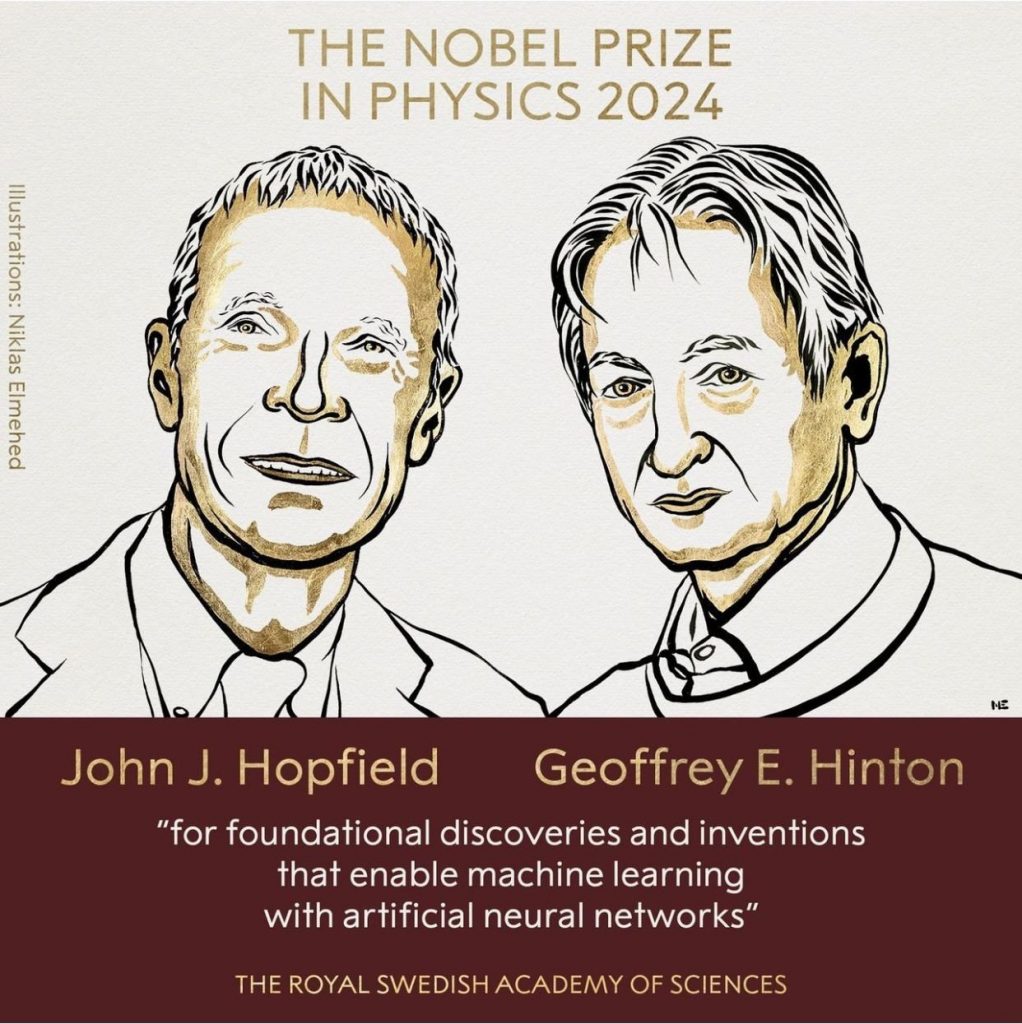Lecture 17
Nobel Prize for Machine Learning; Midterm I Review
October 11, 2024
Nobel Prize in Physics and Chemistry in 2024
The Royal Swedish Academy of Sciences has decided to award the 2024 Nobel Prize in Physics to U.S. scientist John J. Hopfield and British-Canadian Geoffrey E. Hinton for discoveries and inventions in ____________________, a field that enables computers to learn from and make predictions or decisions based on data, which paved the way for the artificial intelligence boom.
Nobel Prize in Physics and Chemistry in 2024


2024 Nobel Prizes: Laying the Foundations for ML
The Breakthroughs Behind AI’s Modern Revolution
- Recognizes groundbreaking contributions to ML and AI
- Hopfield and Hinton: Deep learning and neural network architecture
- Hassabis and Jumper: AI and protein folding breakthroughs
- Why It Matters: These discoveries laid the foundation for the ML revolution we are living through today
2024 Nobel Prizes: Laying the Foundations for ML
Deep Learning
Geoffrey Hinton’s Innovations:
- Developed backpropagation, a key algorithm for training deep neural networks
Deep learning: Multi-layered networks that autonomously learn complex patterns
Impact on AI:
- Enabled machines to learn from data without explicit instructions
- Core technology behind language models (like ChatGPT), image recognition, and more
2024 Nobel Prizes: Laying the Foundations for ML
ML Today
The Scale of Modern AI:
- Deep neural networks now contain billions to trillions of parameters
- Hugging Face: Open-source community for ML and AI
Applications: Voice assistants, self-driving cars, medical diagnostics, and so on.
Importance of Data and Computing Power:
- The explosion in data and cloud computing has fueled rapid progress in AI
- AI models like GPT-4 are direct descendants of Hopfield and Hinton’s early work
2024 Nobel Prizes: Laying the Foundations for ML
Demis Hassabis’s Story: From Chess to AI Mastery


- Boardgame Master Enters the Protein Olympics:
- Early Life:
- Started playing chess at age 4, achieved master level at 13
- Transitioned to programming and video game development as a teenager
2024 Nobel Prizes: Laying the Foundations for ML
Demis Hassabis’s Story: From Chess to AI Mastery

Co-founded DeepMind in 2010, a company that revolutionized AI for boardgames
DeepMind’s Global Attention:
- Sold to Google in 2014
- In 2016, DeepMind’s AI defeated the world champion of Go, a breakthrough in AI’s problem-solving abilities
2024 Nobel Prizes: Laying the Foundations for ML
Demis Hassabis’s Story: From Chess to AI Mastery

- AI’s True Purpose for Hassabis:
- Games were just a stepping stone to developing AI for more meaningful applications, like predicting protein structures
2024 Nobel Prizes: Laying the Foundations for ML
The Future of Machine Learning
- What’s Next?:
- AI is rapidly evolving, expanding into areas like business, economics, climate science, healthcare, personalized medicine, and so on.
- Challenges include transparency, ethics, and responsible AI development
- Ethical Considerations:
- How do we ensure AI benefits humanity and minimizes harm?
- Final Thoughts:
- As AI continues to grow, it holds the potential to solve many of humanity’s greatest challenges
Midterm Exam I Review
Questions 6-8
For Questions 6-8, consider the following data.frame, twitter_data, displayed below:
Question 6
What type of variable is Country in the dataset?
- Nominal
- Ordinal
- Interval
- Ratio
Country: Country of residence
Question 7
What type of variable is LastLoginHour in the dataset?
- Nominal
- Ordinal
- Interval
- Ratio
LastLoginHour: Time of last login in hours since midnight
Question 8
What type of variable is SatisfactionLevel in the dataset?
- Nominal
- Ordinal
- Interval
- Ratio
SatisfactionLevel: User satisfaction level
Question 14
Which of the following R code correctly assigns the data.frame nycflights13::airlines to the variable airlines_df? (Note that airlines_df is simply the name of the R object and can be any valid name in R.)
nycflights13::airlines <- airlines_dfairlines_df <- nycflights13::airlinesnycflights13::airlines >= airlines_dfairlines_df == nycflights13::airlines- All of the above
Question 15
Write the R code to create a new variable called total and assign to it the sum of 8 and 12 in R.
Answer: ______________________________________________
Question 16
Given the data.frame df with variables height and name, which of the following expressions returns a vector containing the values in the height variable?
df:heightdf::heightdf$height- Both b and c
Question 17
The expression as.numeric("456") will return the numeric value 456.
- True
- False
Question 18
What is the result of the expression (1 + 2 * 3) ^ 2 in R?
364981
Question 19
Given vectors a <- c(2, 4, 6) and b <- c(1, 3, 5), what is the result of a + b?
c(3, 7, 11)c(2, 4, 6, 1, 3, 5)c(1, 2, 3, 4, 5, 6)Error
Question 20
To use the function read_csv() from the readr package, one of the packages in tidyverse, you first need to load the package using the R code ________.
library(readr)library(skimr)library(tidyverse)- All of the above
- Both a and c
- Both b and c
- Both a and c
Question 21
Consider the following data.frame df0:
| x | y |
|---|---|
| Na | 7 |
| 2 | NA |
| 3 | 9 |
What is the result of mean(df0$y)?
7NA89
Questions 22-23
Consider the following data.frame df for Questions 22-23:
| id | name | age | score |
|---|---|---|---|
| 1 | Anna | 22 | 90 |
| 2 | Ben | 28 | 85 |
| 3 | Carl | NA | 95 |
| 4 | Dana | 35 | NA |
| 5 | Ella | 40 | 80 |
Question 22
Which of the following code snippets filters observations where score is strictly between 85 and 95 (i.e., excluding 85 and 95)?
df |> filter(score >= 85 | score <= 95)df |> filter(score > 85 | score < 95)df |> filter(score > 85 & score < 95)df |> filter(score >= 85 & score <= 95)
Question 23
Which of the following expressions correctly keeps observations from df where the age variable does not have any missing values?
df |> filter(is.na(age))df |> filter(!is.na(age))df |> filter(age == NA)df |> filter(age != NA)- Both a and c
- Both b and d
Question 24
Consider the following data.frame df3:
| id | value |
|---|---|
| 1 | 15 |
| 1 | 15 |
| 2 | 25 |
| 3 | 35 |
| 3 | 35 |
| 4 | 45 |
| 5 | 55 |
Which of the following code snippets returns a data.frame of unique id values from df3?
df3 |> select(id) |> distinct()df3 |> distinct(value)df3 |> distinct(id)- Both a and c
Question 25
Which of the following code snippets correctly renames the variable name to first_name in df?
df |> rename(first_name = name)df |> rename(name = first_name)df |> rename("name" = "first_name")df |> rename_variable(name = first_name)
Question 26
Which of the following code snippets correctly removes the score variable from df?
df |> select(-score)df |> select(-"score")df |> select(!score)df |> select(, -score)df |> select(desc(score))
Question 27
Which of the following code snippets filters observations where age is not NA, then arranges them in ascending order of age, and then selects the name and age variables?
df |> filter(!is.na(age)) |> arrange(age) |> select(name, age)df |> select(name, age) |> arrange(age) |> filter(!is.na(age))df |> arrange(age) |> filter(!is.na(age)) |> select(name, age)df |> filter(is.na(age)) |> arrange(desc(age)) |> select(name, age)- All of the above
Question 28
Consider the two related data.frames, students and majors:
df_1
| student_id | name | age |
|---|---|---|
| 1 | Brad | 20 |
| 2 | Jason | 22 |
| 4 | Marcie | 21 |
df_2
| student_id | major |
|---|---|
| 1 | Business Administration |
| 2 | Economics |
| 3 | Data Analytics |
| student_id | major | name | age |
|---|---|---|---|
| 1 | Business Administration | Brad | 20 |
| 2 | Economics | Jason | 22 |
| 3 | Data Analytics | NA | NA |
students |> left_join(majors)majors |> left_join(students)- Both a and b
Question 29
In R, what does the function sd(x) compute, and why can it be more useful than var(x)?
Question 30
List at least four applications of data analytics in sports analytics mentioned in the lecture, and briefly describe each one.